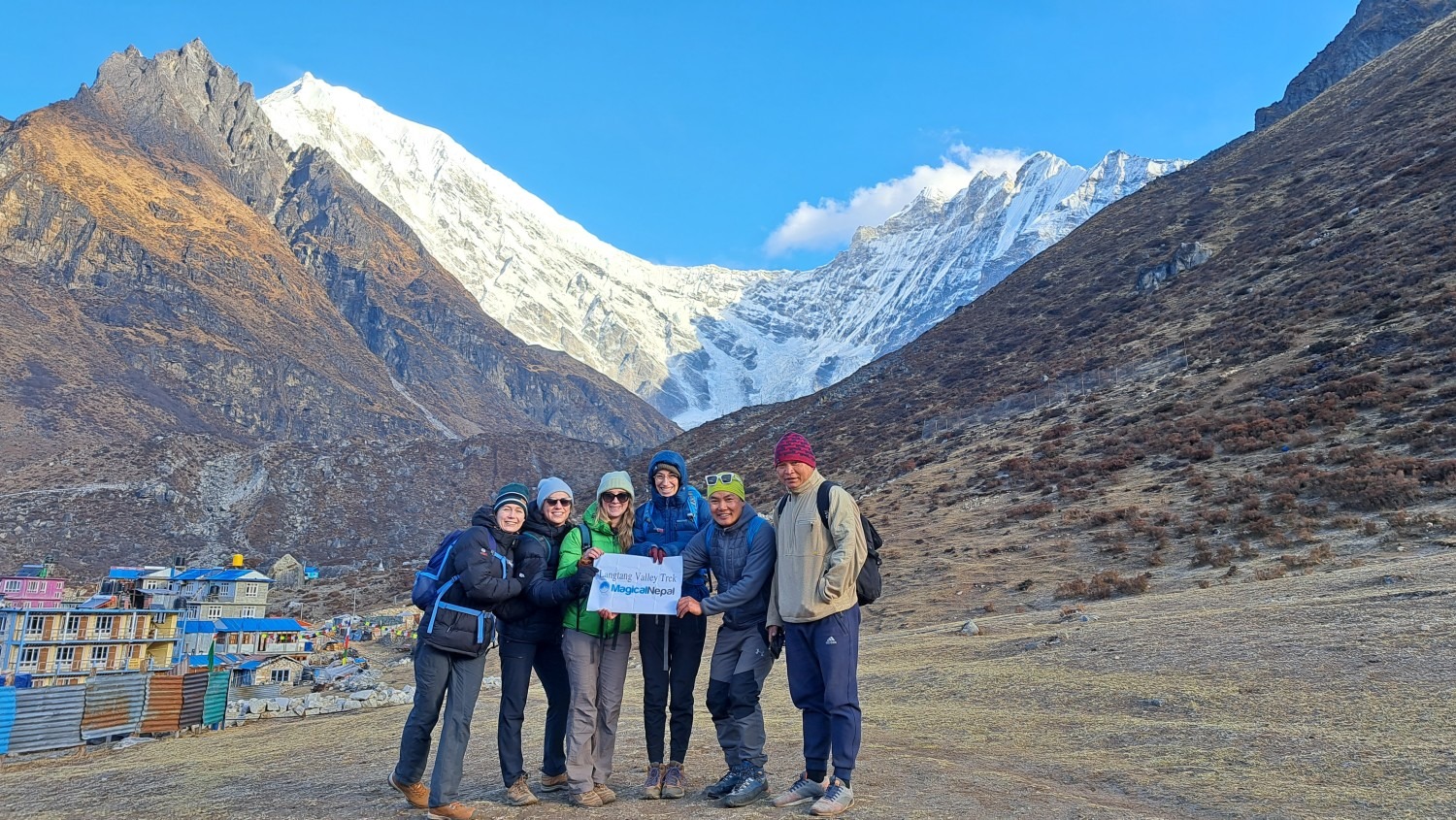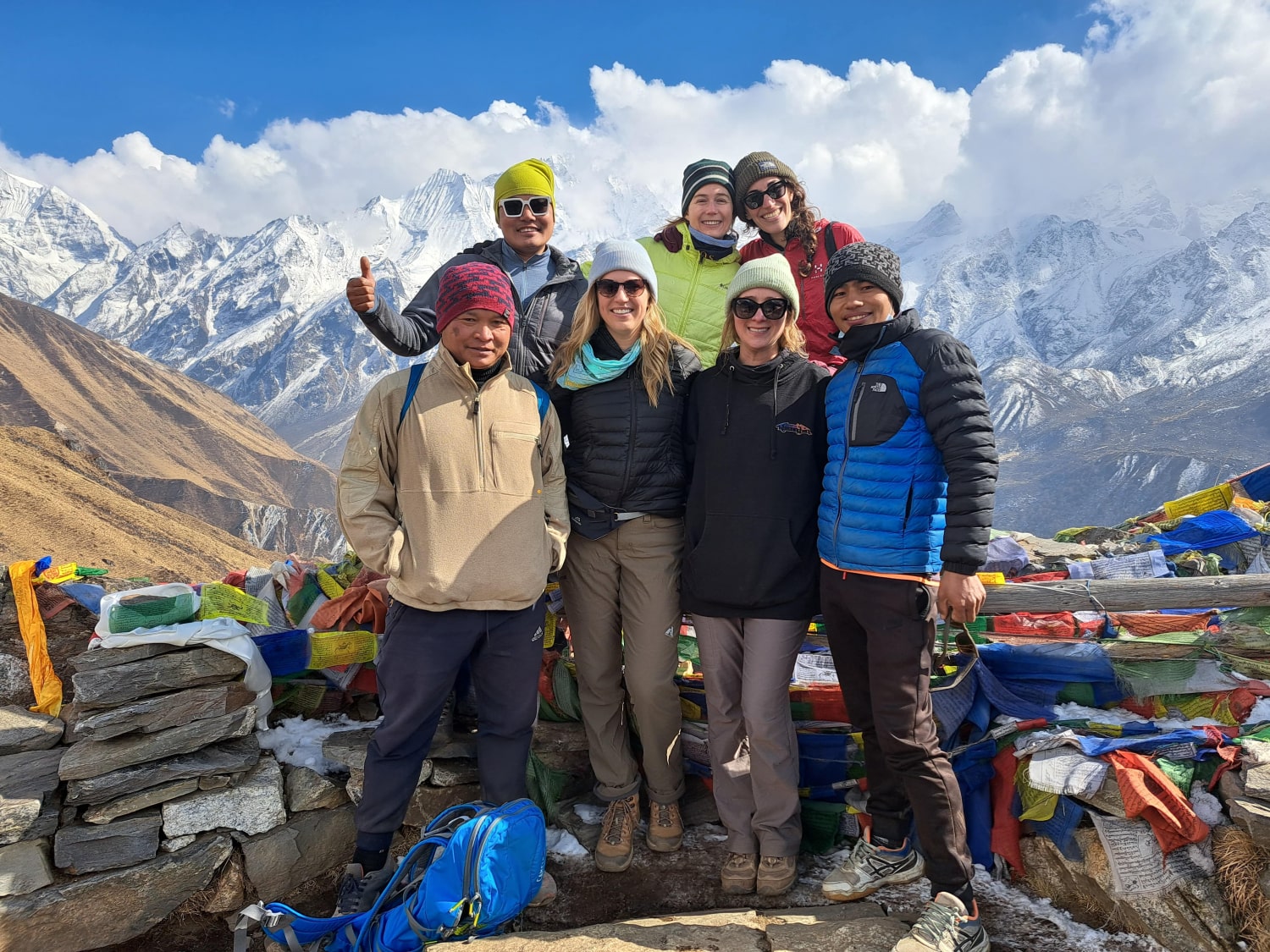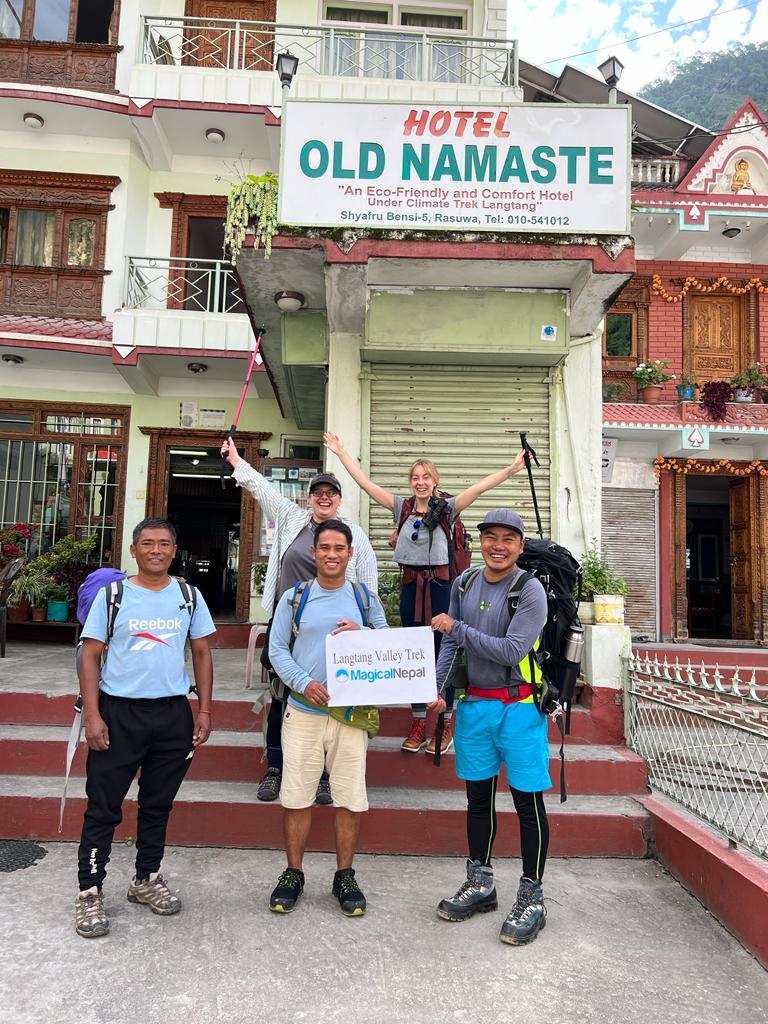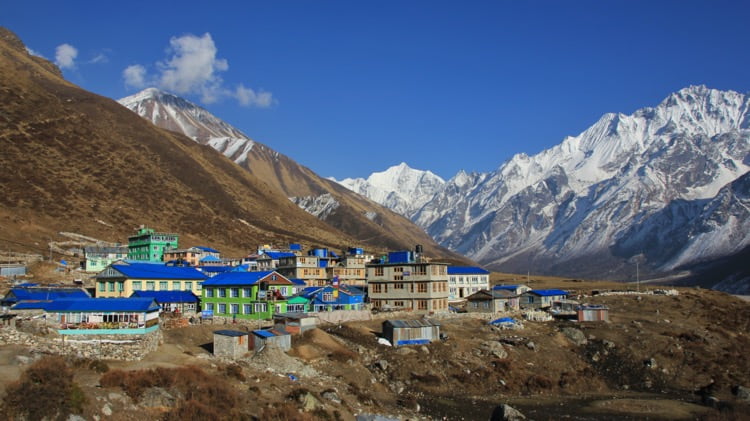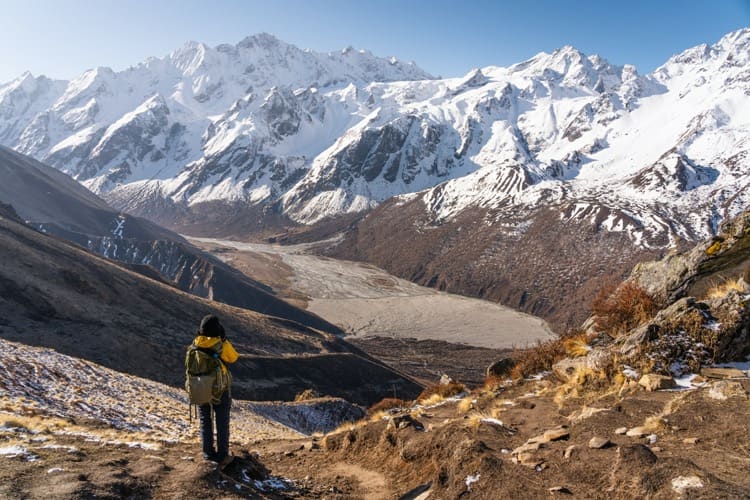Langtang Valley Trek
| Starts at: Syabrubesi | Ends at: Syabrubesi |
| Trek Region: Langtang | Transport: Public Bus |
| Duration: 8 days | Trip Grade: Moderate |
| Max Altitude: 4800 m / 15655 ft (Kyanjing Ri) | Accommodation: Teahouse |
Langtang Valley Trek highlights
- No need to book a plane! You can drive to this trek within 7 to 8 hours
- Trek through the Langtang Valley, also known as the ‘Valley of Glaciers’
- Climb Tserko Ri for its stunning scenic views.
- View of snow-capped mountains such as Langtang Ri, Langtang, Langsisa and Ganjala Peak
- Experience Tibetan Buddhist culture and life firsthand
- Walkthrough spectacular rhododendron forests
- Collect blessings at old Buddhist shrines such as Langtang Gompa and Kyanjing Gompa
- Stay in interesting teahouses along the route
- One of the lesser-known treks in Nepal
Although the Langtang Valley can be reached by a day’s drive from the Kathmandu Valley, this area remains unknown to most trekkers.
While many recognize the names Everest Base Camp Trek, Annapurna Circuit, and Annapurna Base Camp Trek, few recognize the name Langtang Valley Trek.
Dominated by the Langtang Himalayas, this valley trek is relatively short but runs through rhododendrons and bamboo forests alongside thundering waterfalls and stunning snow-capped mountains.
The trail takes you to an altitude of 4,000m /13,123 ft, and if you want to go higher, you’d not want to miss seeing the sunrise from the Tserko Ri at 5,000m / 16,404 ft.
This diverse trek introduces you to the Tamangs and Sherpas Buddhist culture. The ancient monastery of Kyanjin Gompa, situated near Tserko, upholds this tradition. The spectacular views on this trek include Dorje Lakpa (6,990m / 22,933 ft), Langtang Ri (6,370m / 20,898 ft), and Langtang Lirung (7,245m / 23,769 ft).
The trek passes through Langtang National Park, a pristine countryside with majestic flora and fauna, yak pastures, and local cheese factories! Himalayan pheasants, deer, bears, monkeys, and the elusive red panda are native to this region.
Langtang Village was utterly destroyed during the April 2015 earthquake. The resilient locals have been rebuilding; teahouses and lodges have been rebuilt and opened. The best way for people to help us continue visiting this area.
This is a perfect trek for those who want to explore this off-beat track and see something completely different from many of the country’s more touristy areas.
Similarly, this is the perfect introduction for those discovering Nepal for the first time.
Langtang Valley Trek Outline Itinerary
Day 1: Kathmandu to Syabrubesi
Syabrubesi – 1550 m / 5085 ft 7-8 hrs
Day 2: Trek to Lama Hotel
Lama Hotel – 2380 m / 7808 ft – 6 hrs
Day 3: Lama Hotel to Langtang Village
Langtang Village – 3430 m / 11253 ft – 7 hrs
Day 4: Lantang Village to Kanjin Gompa
Kyanjin Gompa – 3870 m / 12696 ft – 3 hrs
Day 5: Kyanjin Gompa to Tserko Ri to Kyanjin Gompa
Tserko Ri – 5000 m / 16404 ft 8-9 hrs
Day 6: Kyanjin Gompa to Lama Hotel
Lama Hotel – 2380 m / 7808 ft 6-7 hrs
Day 7: Lama Hotel to Syabrubesi
Syabrubesi – 1550 m / 5085 ft 6-7 hrs
Day 8: Syabrubesi to Kathmandu ( Drive )
Kathmandu – 1380 m / 4572 ft 8 – 9 hrs
Day 1: Kathmandu to Syabrubesi
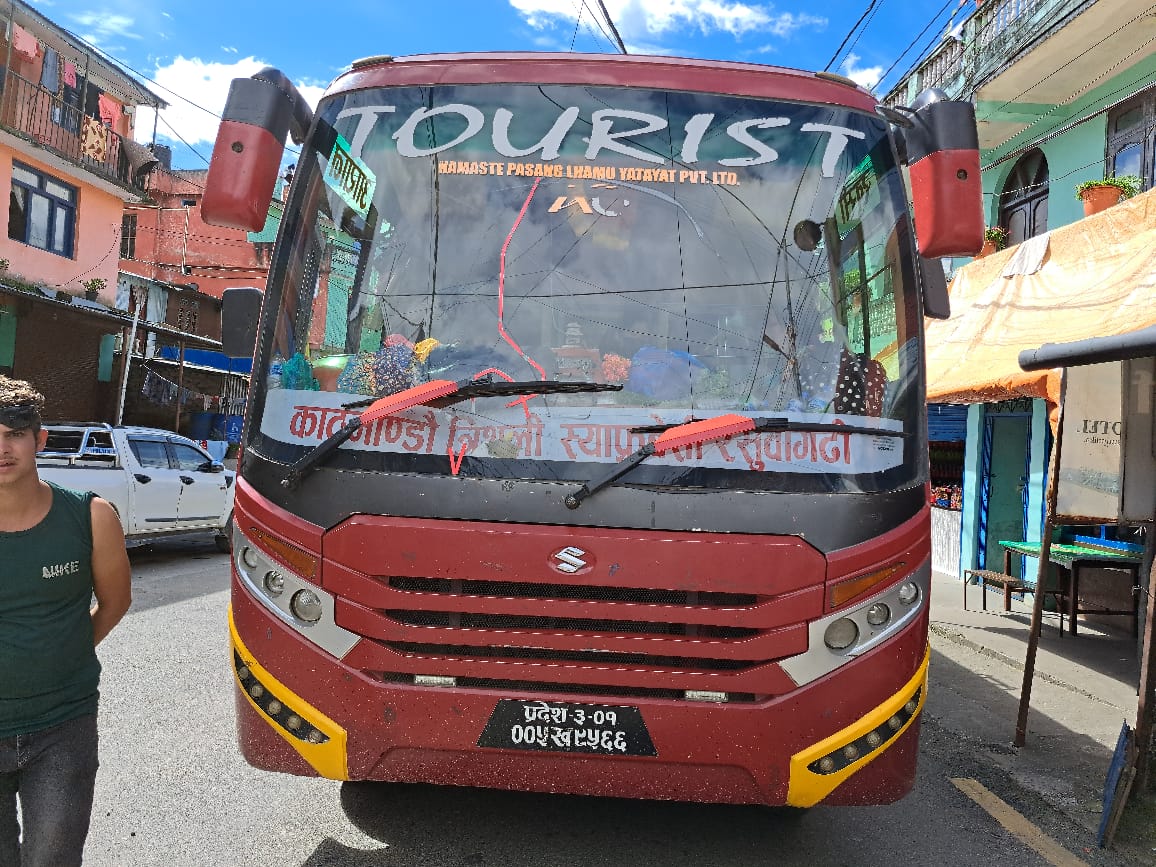
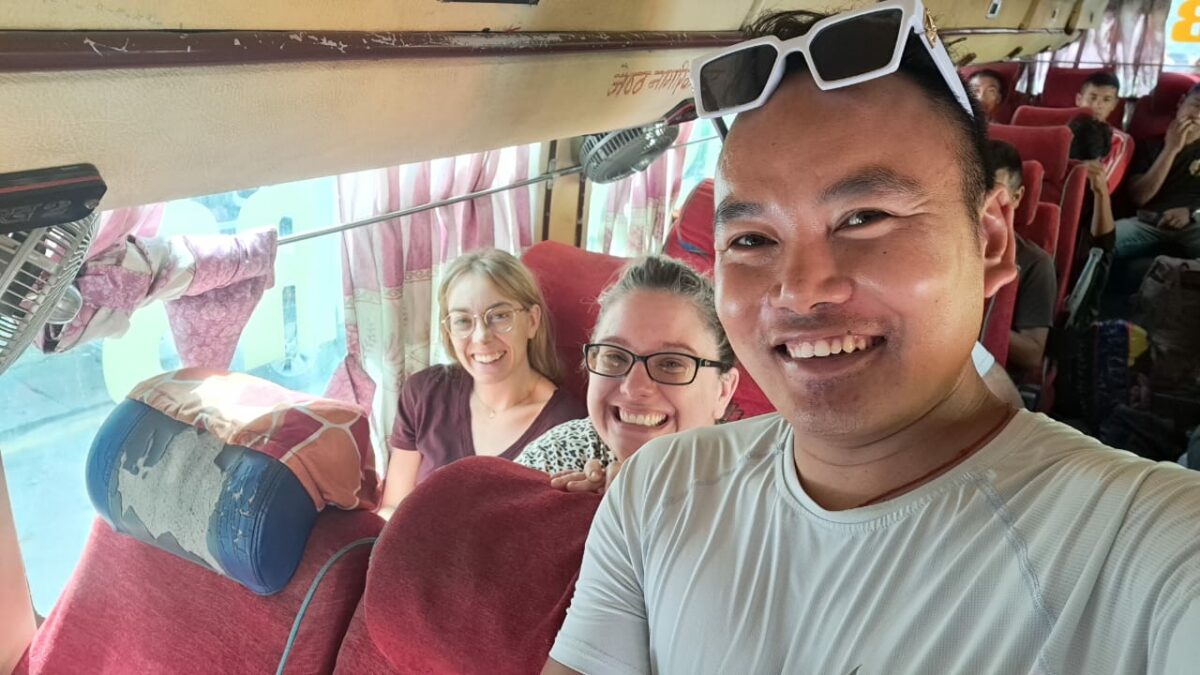
- Drive time: 6 to 7 hours
- Accommodation: Tea House
- Distance: 122 km /75 miles
Getting to the Langtang Valley Trek starting point is straightforward: a 7 or 8-hour bus journey from Kathmandu.
That’s not to say it’s dull—far from it! Driving along the Trisuli River, you may be fortunate to see whitewater rafters taking on the mighty rapids. But look up—already, the mountains are welcoming you. On reaching Trisuli Bazaar, the Manaslu Massif, Ganesh, Jungal Himal, and Langtang stand tall overhead.
The road is a bit bumpy from this point, so be prepared. It’s around 50 km / 31 miles to Dhunche, then another 15 km / 9 miles to Syabrubesi, where we stop for the night before beginning the trek proper the following day.
In front of the Hotel in Syabrubesi
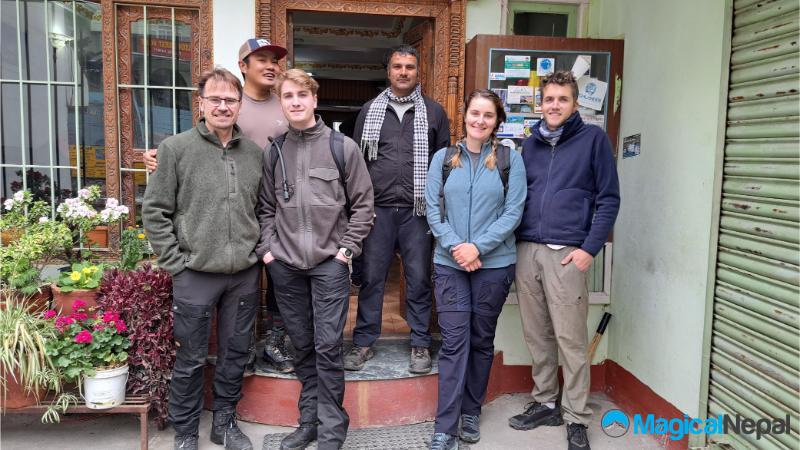
Day 2: Trek to Lama Hotel
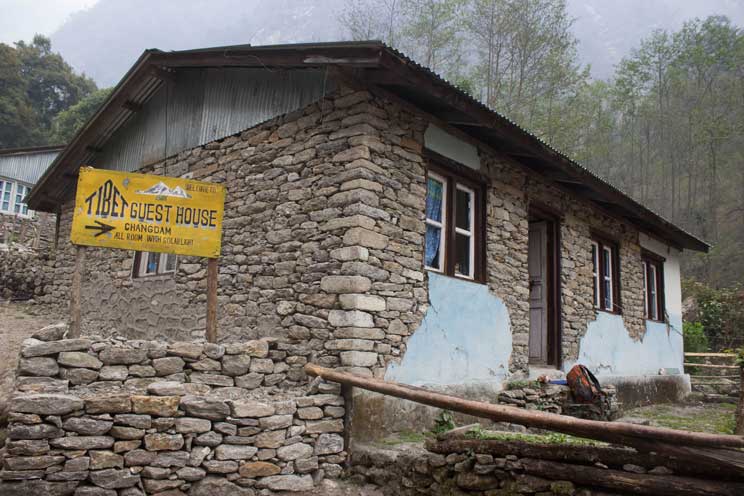
- Trek time: 6 hours
- Accommodation: Tea House
- Trek Distance: 11.3 km /7 miles
Another walk through a beautiful forest with Langtang Lirung as the backdrop. When we reach Ghora Tabela, the trail enters green meadows, and we can see the Langtang Range stretching on both sides of the valley. Walking on, the valley widens, and we can see herders graze their livestock on the high summer pastures.
Today, there are only temporary settlements and an army post. This was once the teaming village of Langtang, with its many trekkers’ tea houses. Today the area is full of boulders, deprived of life after the 2015 earthquake.
Walking for half an hour or so, we reach the village of Mundu. Our overnight stop at Mundu is very comfortable, with its more modern buildings and facilities.
What to Expect
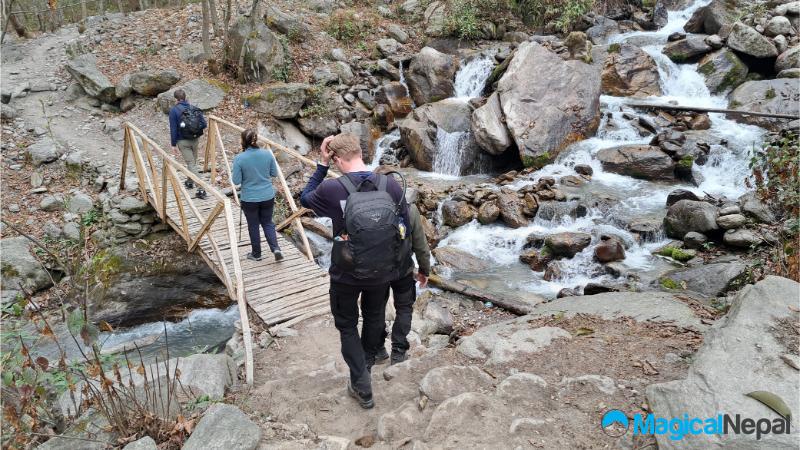
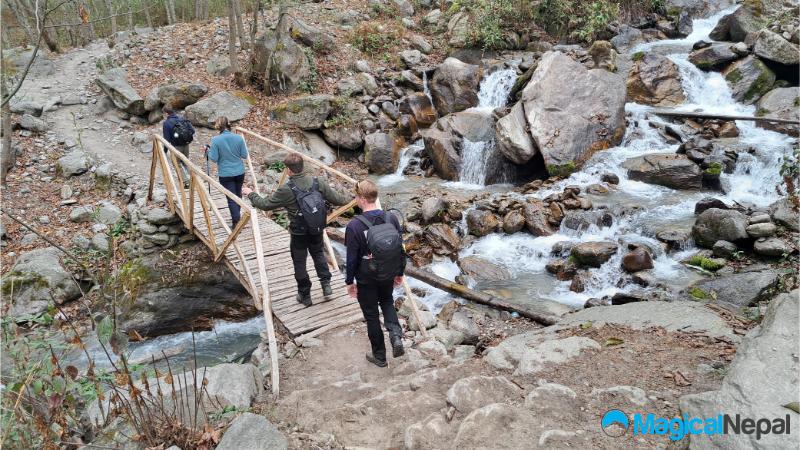
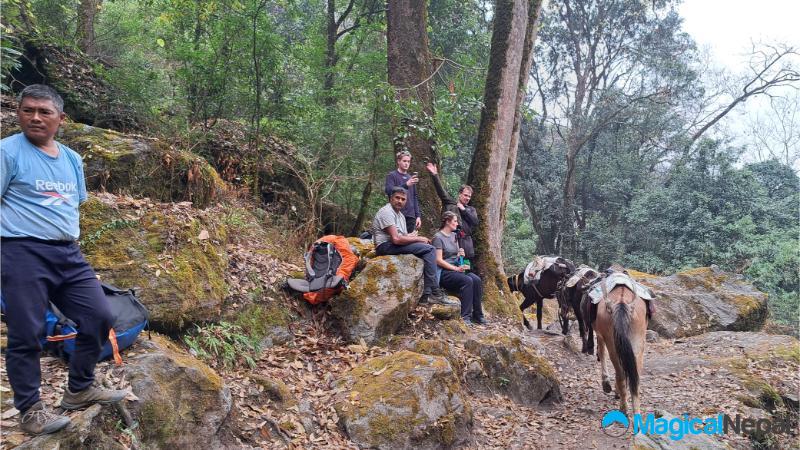
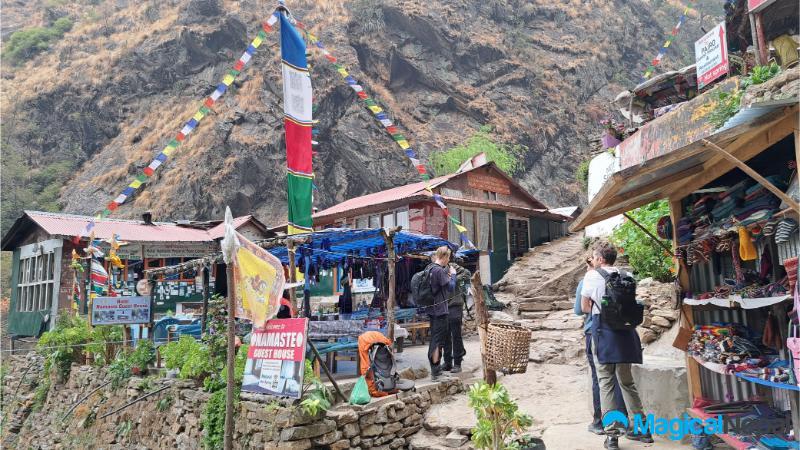
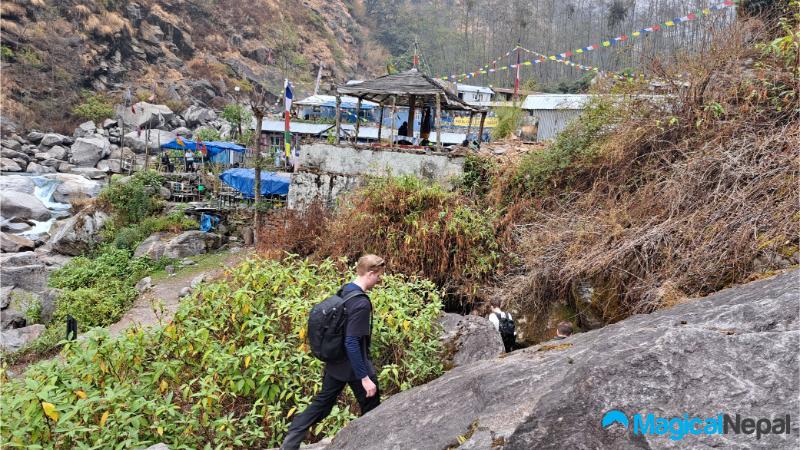
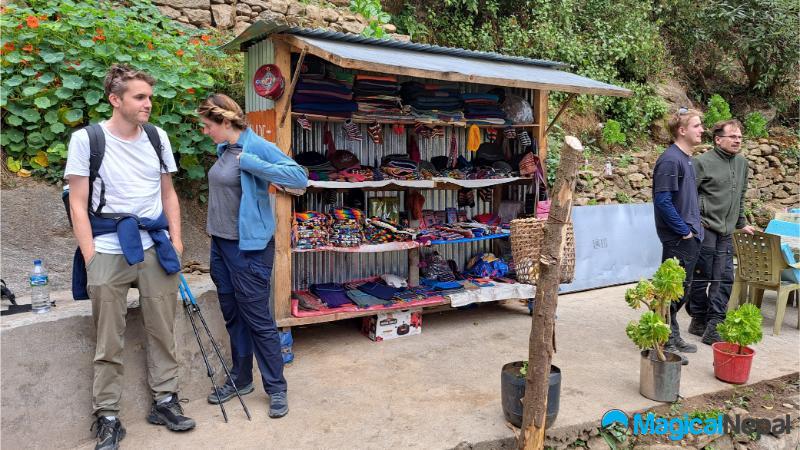
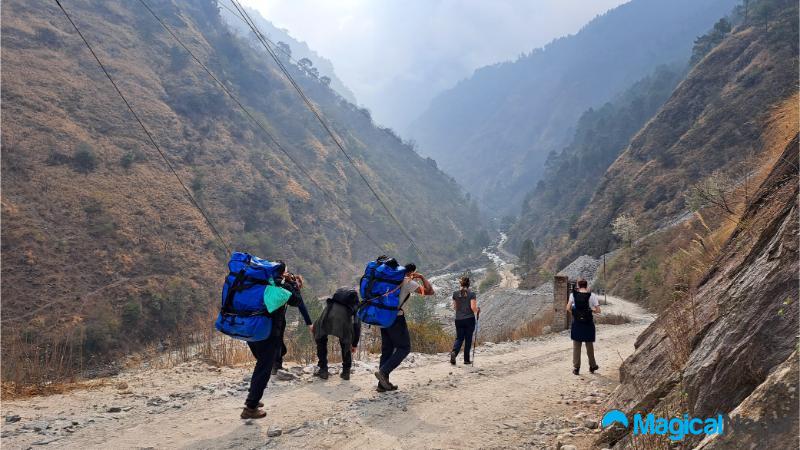
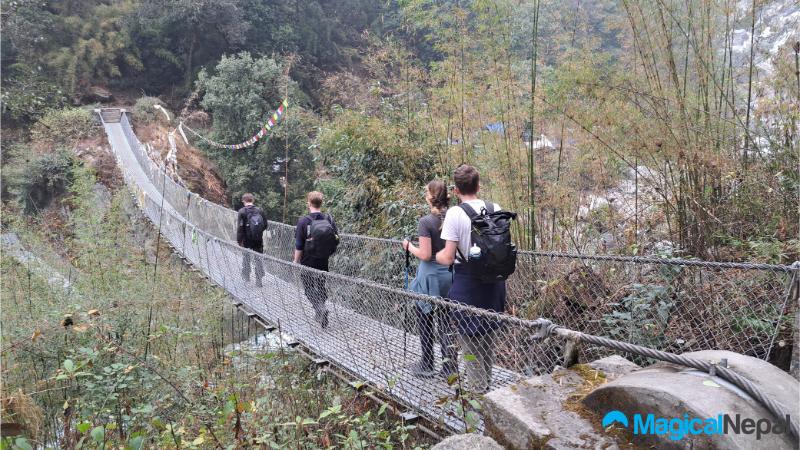
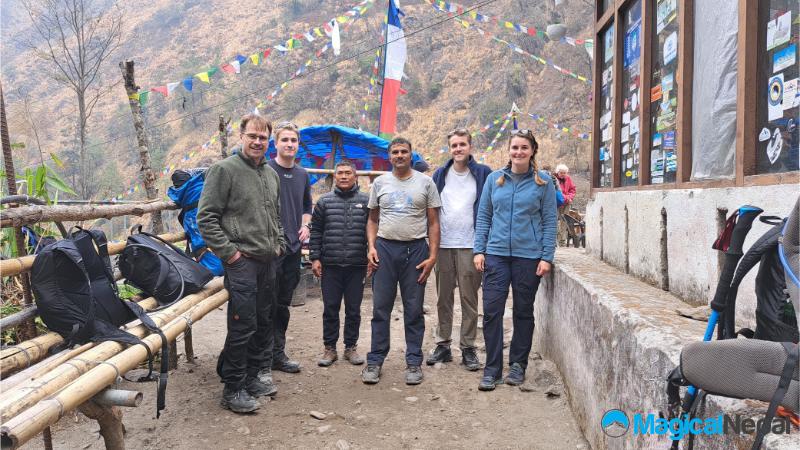
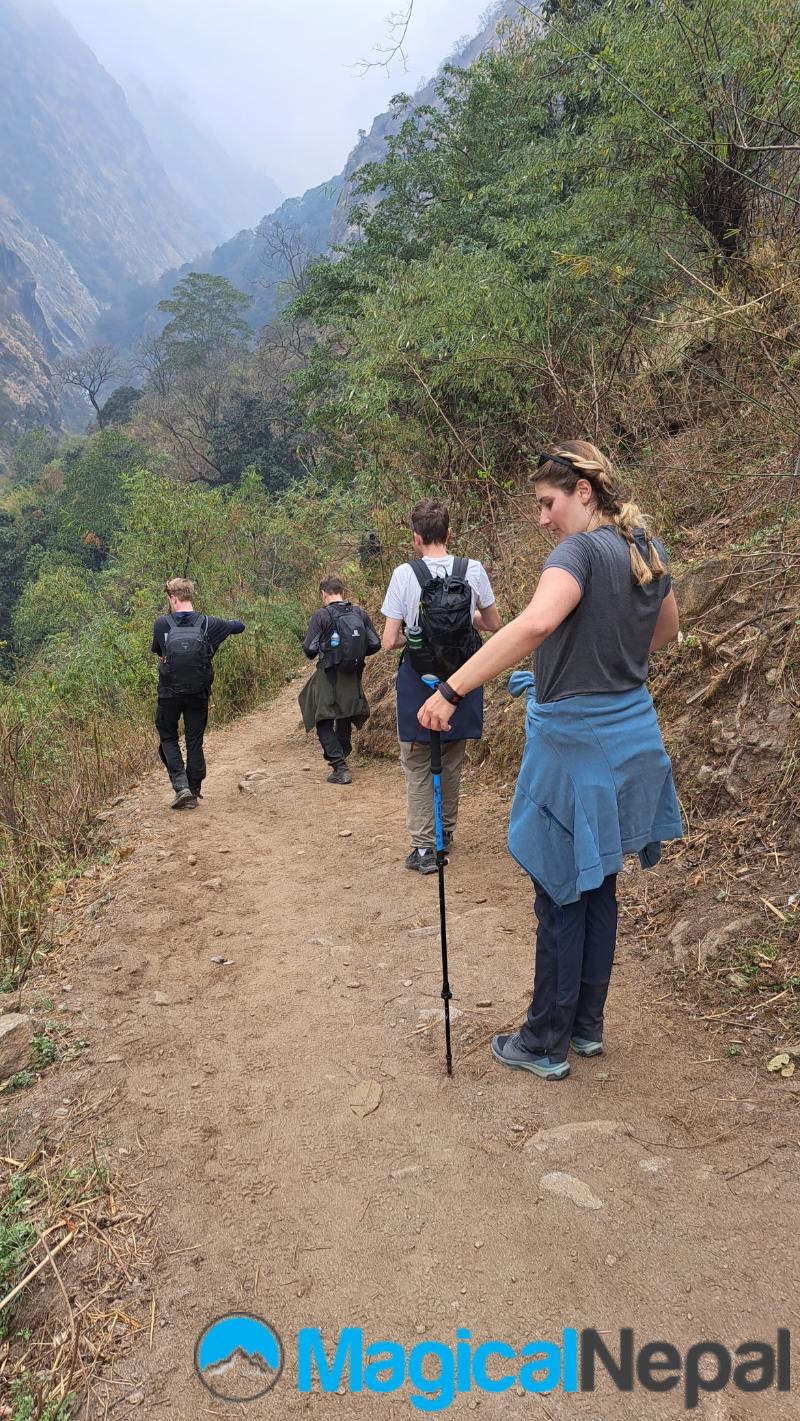
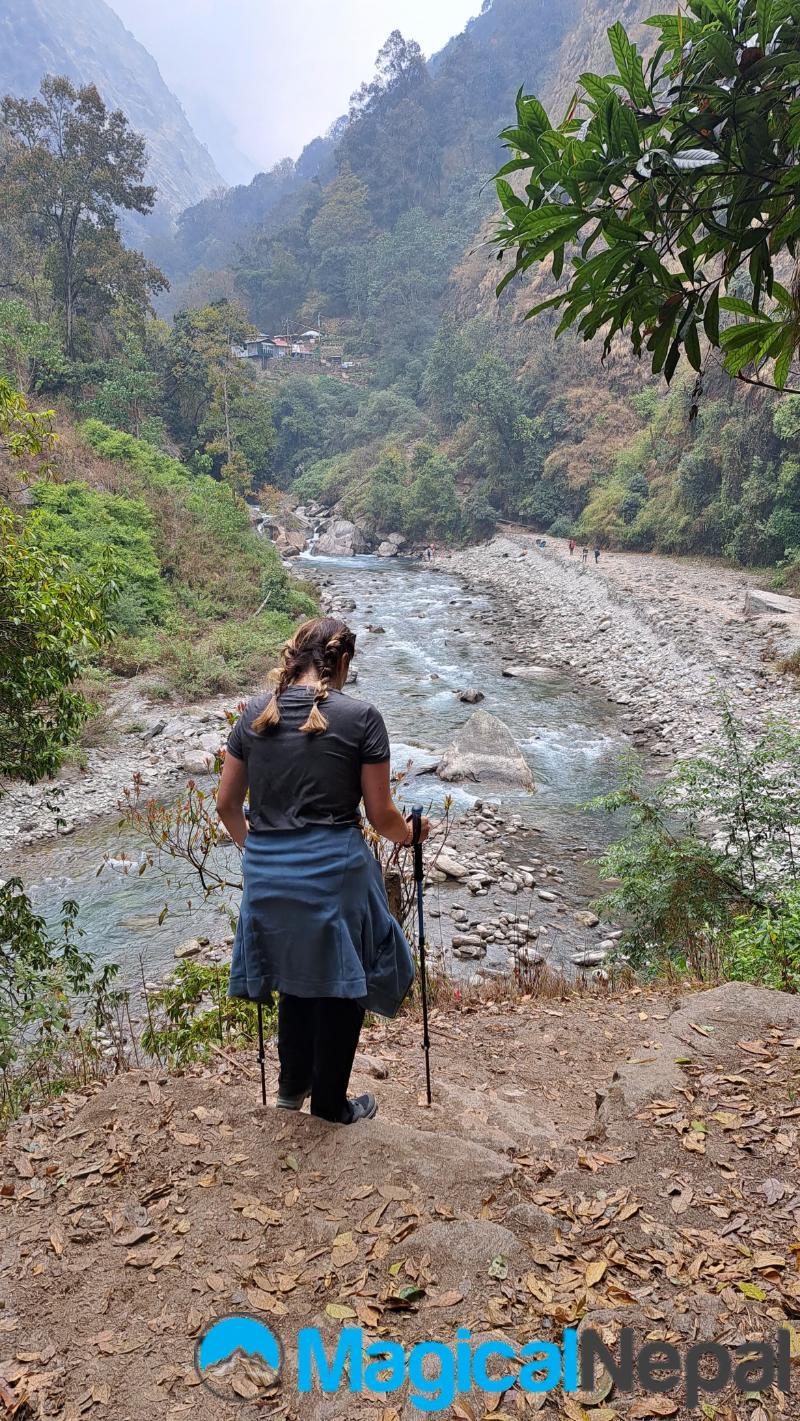
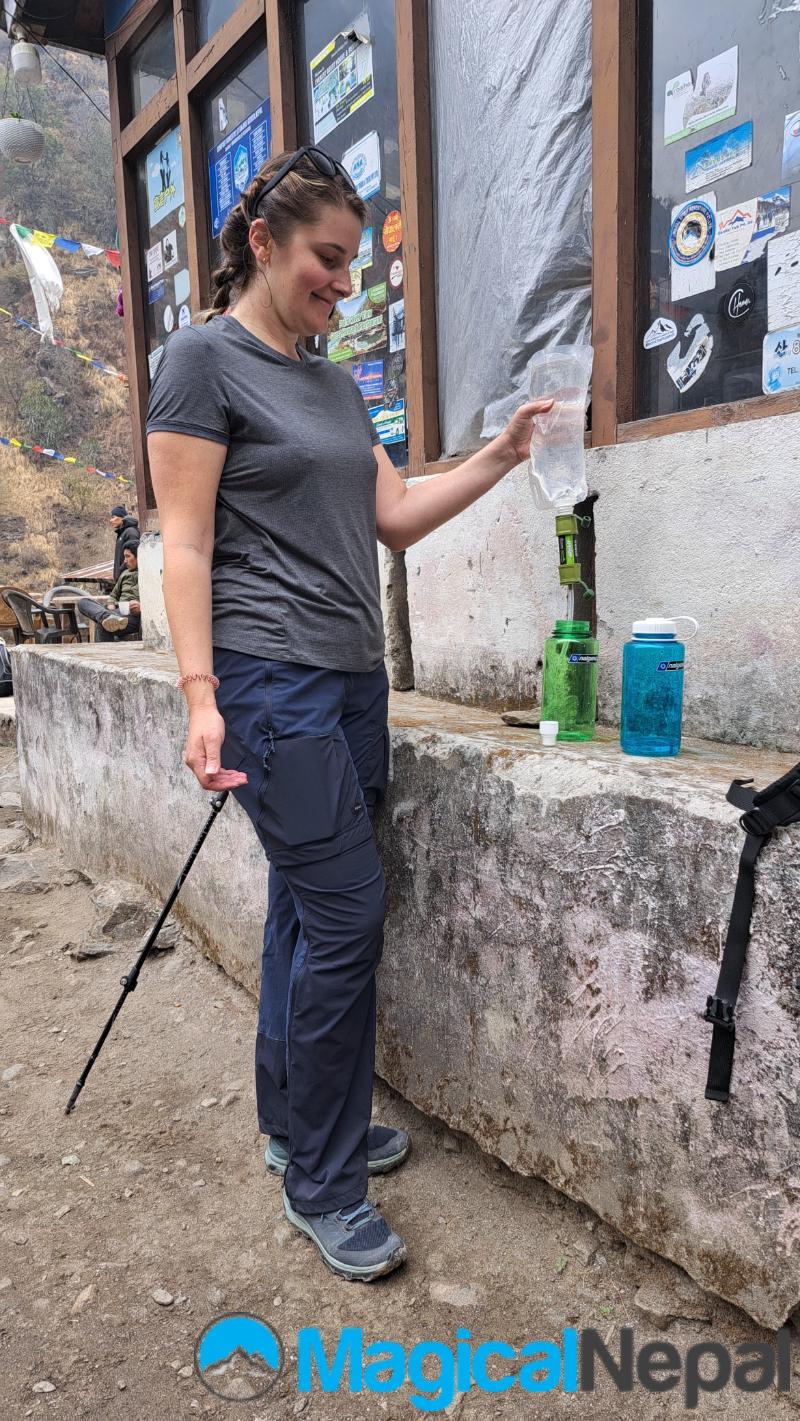
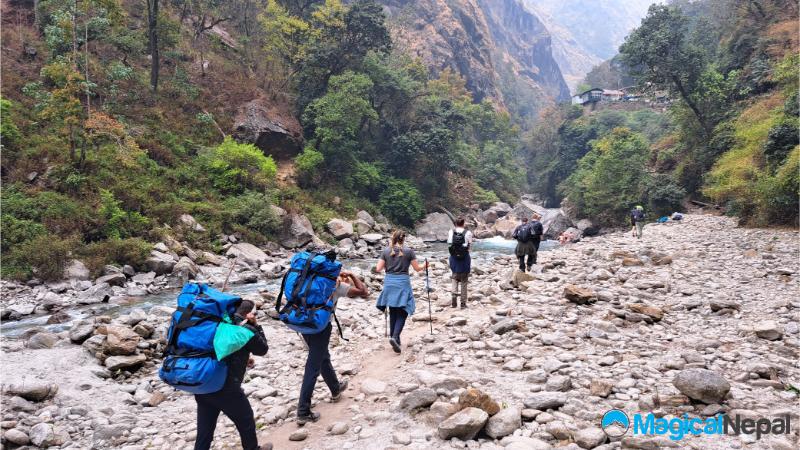
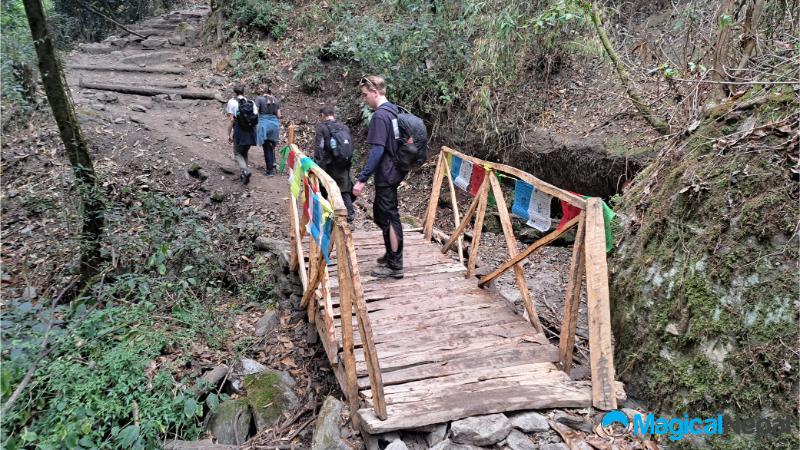
Day 3: Lama Hotel to Langtang Village
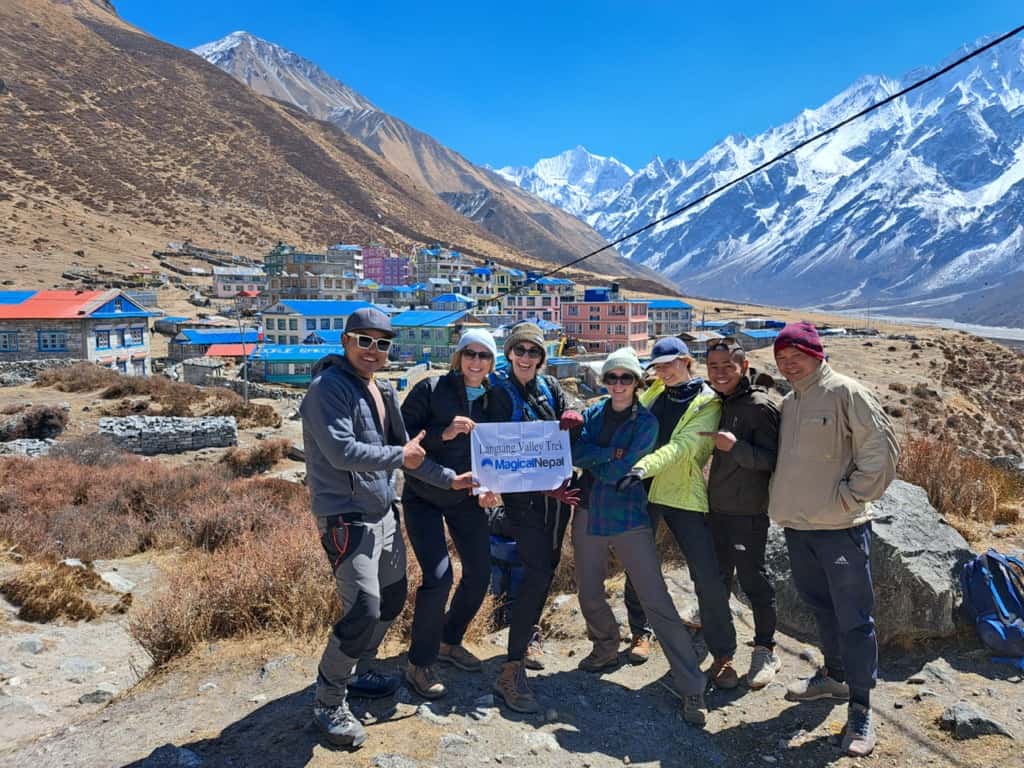
- Trek time: 7 hours
- Accommodation: Tea House
- Trek Distance: 14.7km /8 miles
You will pass through the forest and reach Ghoretable after a 3-hour hike. Ghoretable is a horse stable. The trek continues, and you will reach Langtang Village.
The 2015 earthquake destroyed Langtang village, but it has since been rebuilt. You can stay in Langtang Village or Mundu, which is the next stop from Langtang Village. You will see glorious views of Langtang and Gonchompe.
The Langtang village thrives with a community health post, government schools, small markets, and monasteries.
What to Expect
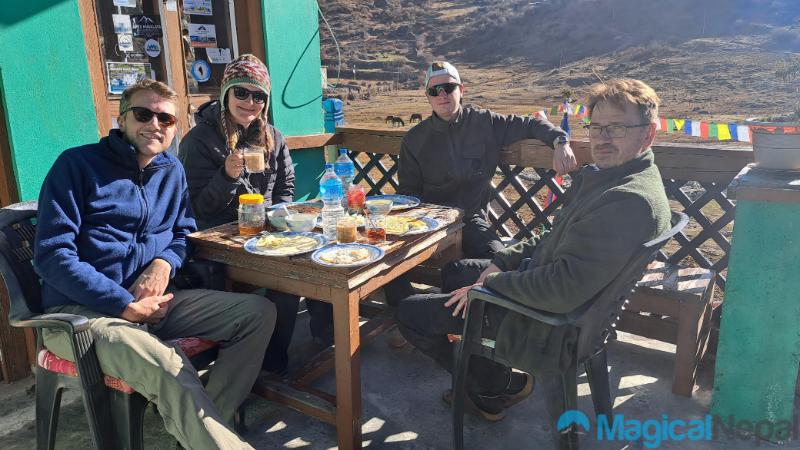
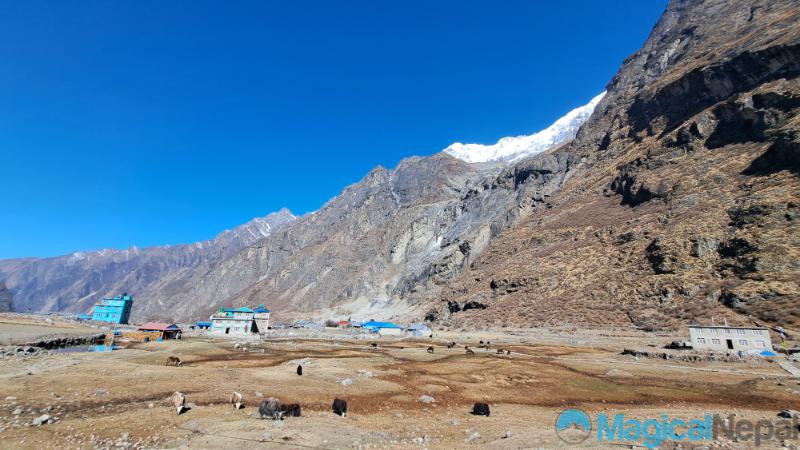
Day 4: Langtang to Kyanjin Gompa
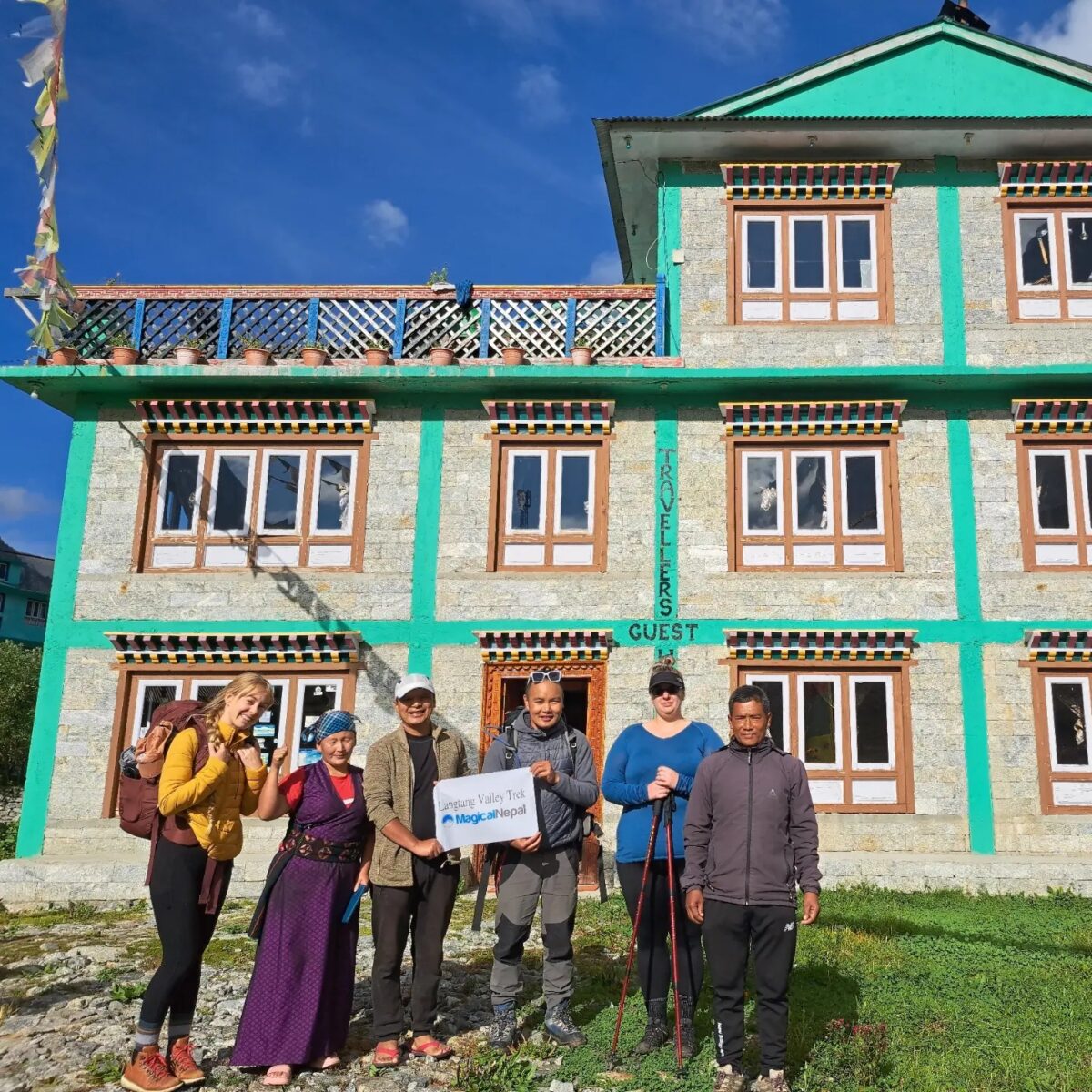
- Trek time: 6 hours
- Accommodation: Tea House
- Trek Distance: 5.7 km/3.5 miles
The route is shorter today, and it is lined with Buddhist artifacts, such as Chortens, prayer flags, and rocks with Buddhist inscriptions carved into them.
Watermills and yak pastures are also interesting, as are the wonderful mountain views. Reaching Kyanjin Gompa by lunchtime allows one to relax or explore the area.
Why not hike towards Langshisha Kharka, which has wonderful views? We overnight in the Gompa and enjoy the area’s spirituality and mountains.
What to Expect
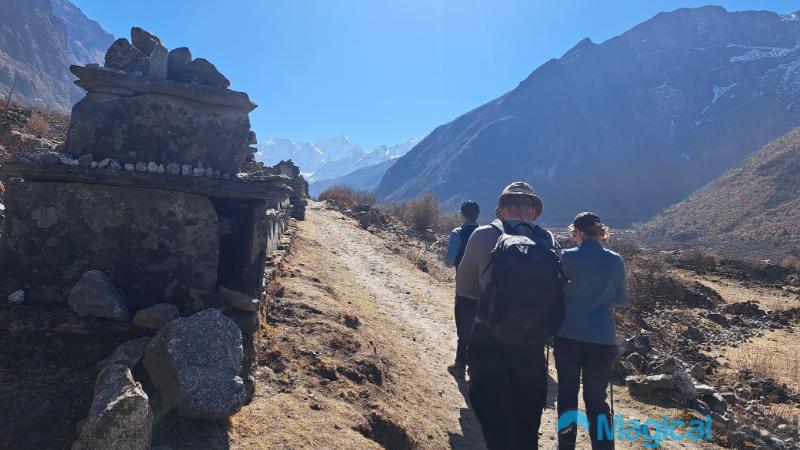
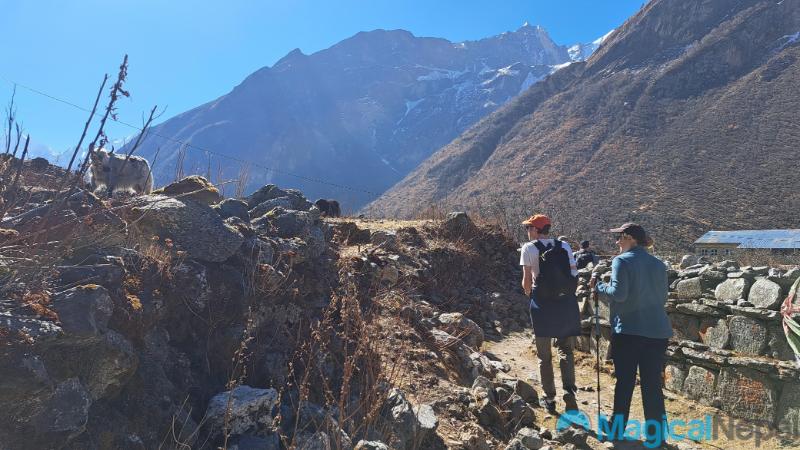
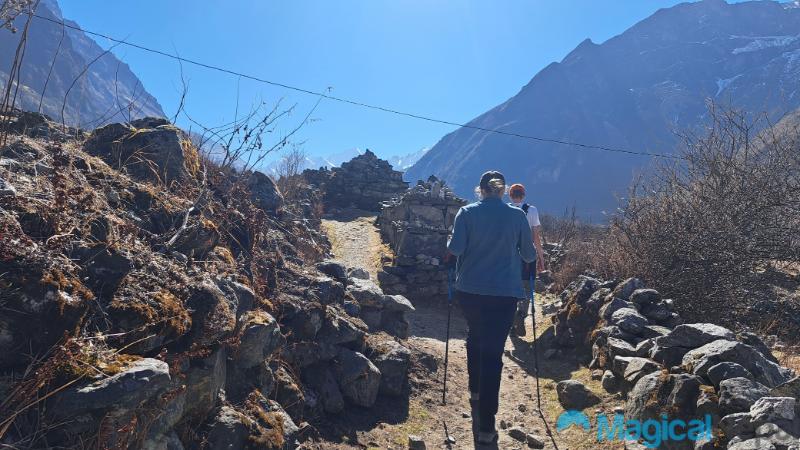
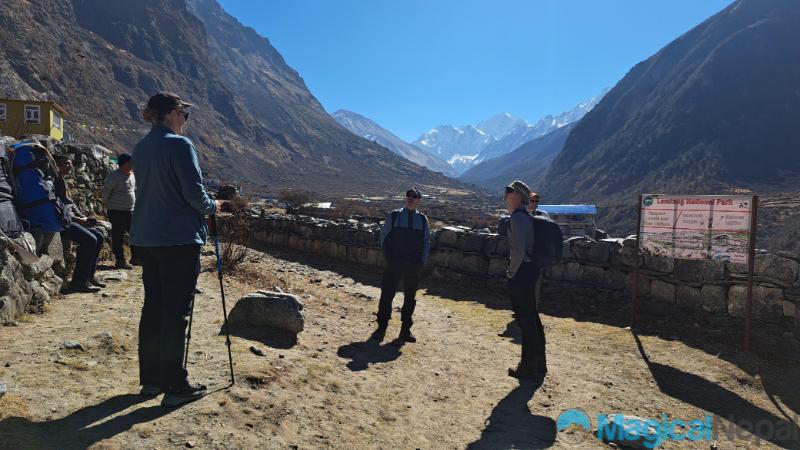
Day 5: Kyanjin Gompa to Tserko Ri to Kyanjin Gompa
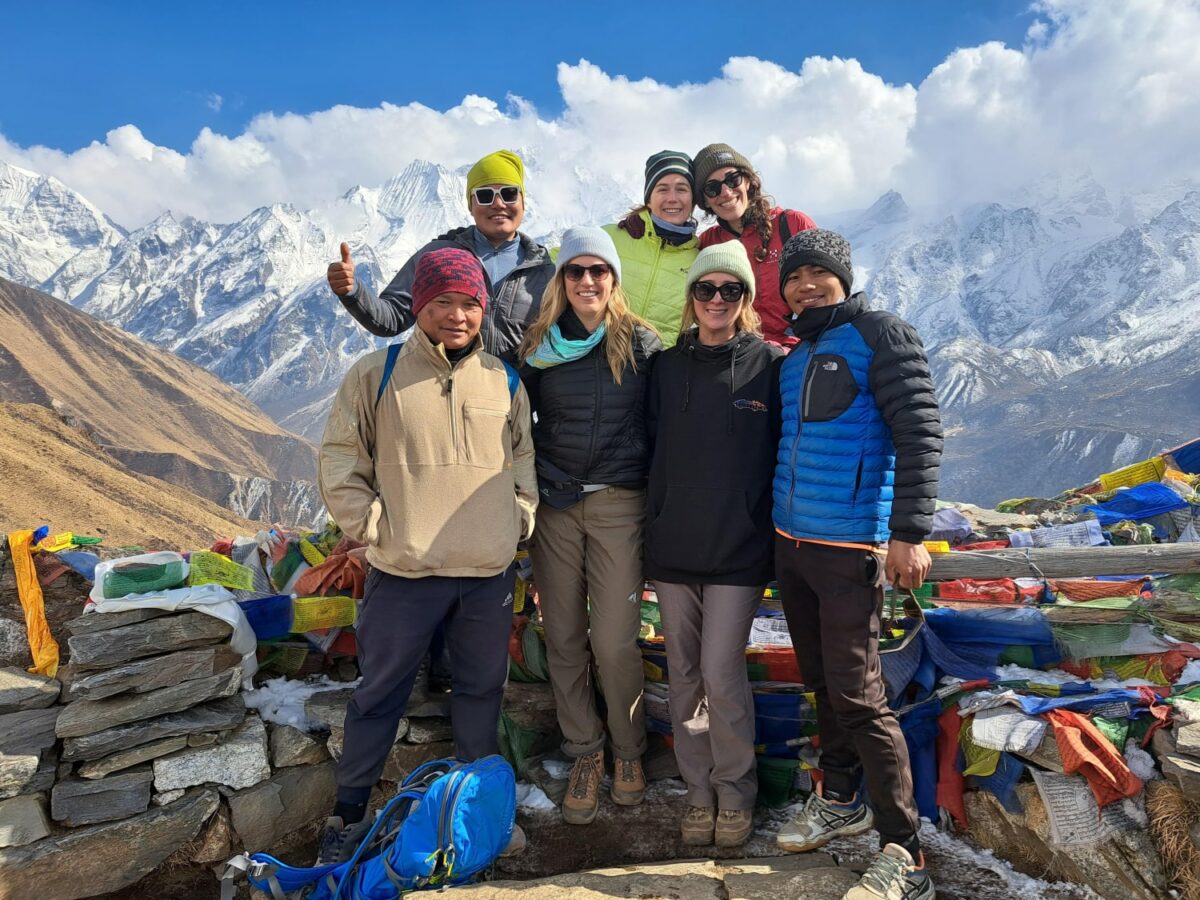
- Trek time: 9 to 10 hours
- Accommodation: Tea House
- Trek Distance: 17 km/10 miles
This is an exciting but challenging day to hike up Tsergo Ri (5,000m /16404 ft), from where we can see over 20 peaks, the Langtang Valley, and frozen lakes.
The views and exhilarating experience make this hard upward hike well worthwhile! After taking in the breathtaking views, return to Kyanjin Gompa for a second night and a well-deserved dinner.
What to Expect
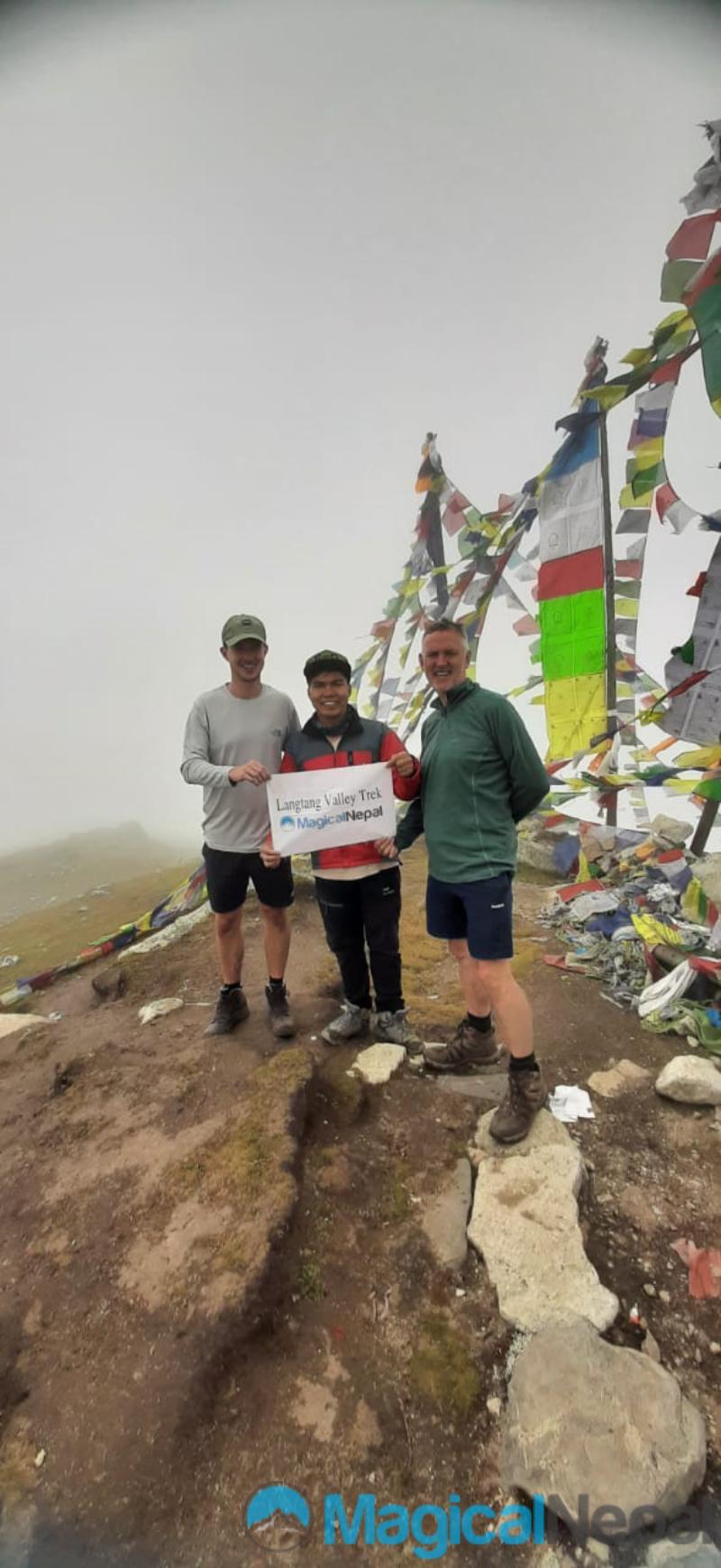
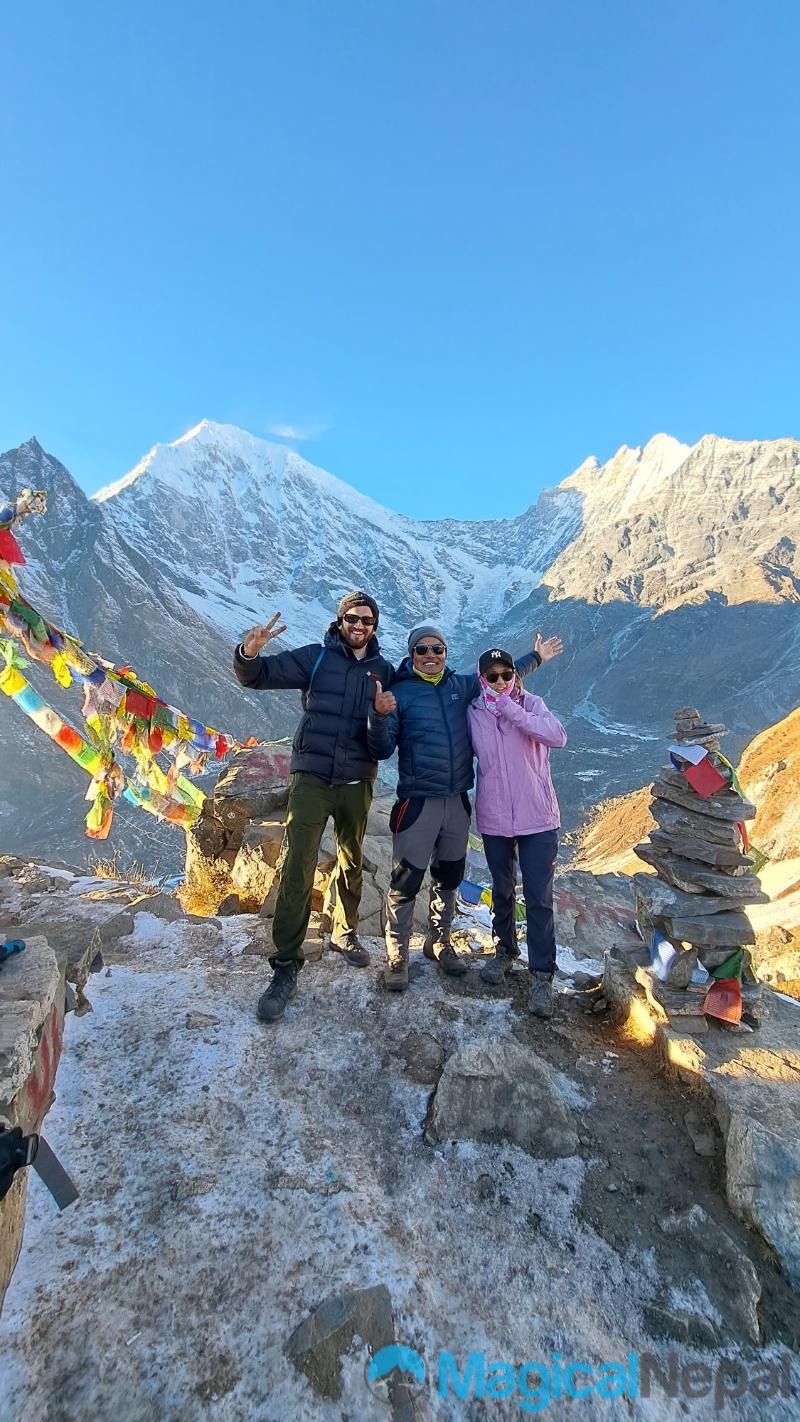
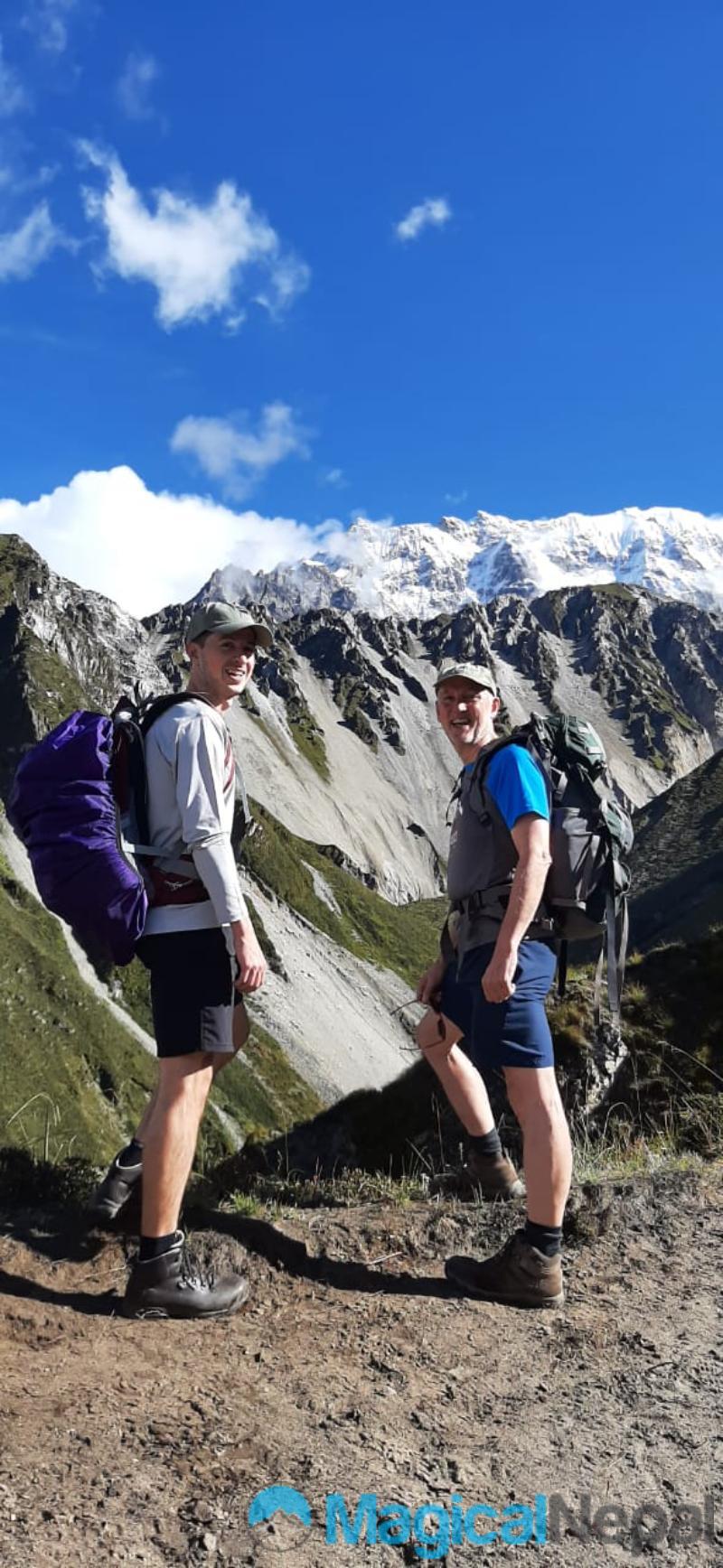
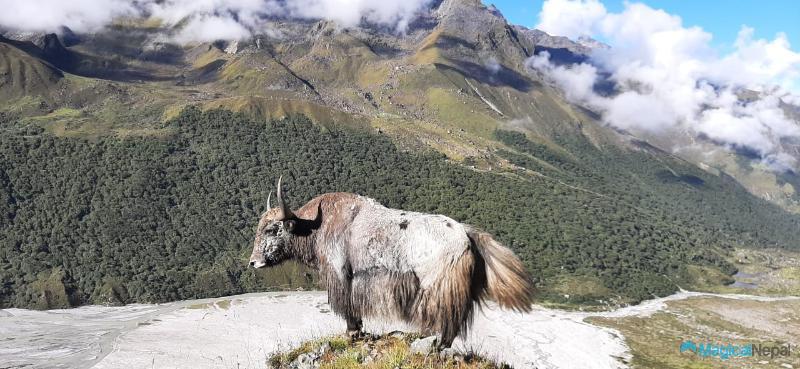
Day 6: Kyanjin Gompa to Lama Hotel
- Trek time: 6 hours
- Accommodation: Tea House
- Trek Distance: 14.5 km /9 miles
Today we retrace our steps to Lama Hotel by crossing streams and hiking through forests. After the extra effort of the previous day’s challenging trek. Overnight at Lama Hotel.
Day 7: Lama Hotel to Syabrubesi
- Trek time: 6 hours
- Accommodation: Tea House
- Trek Distance: 11.3 km /7 miles
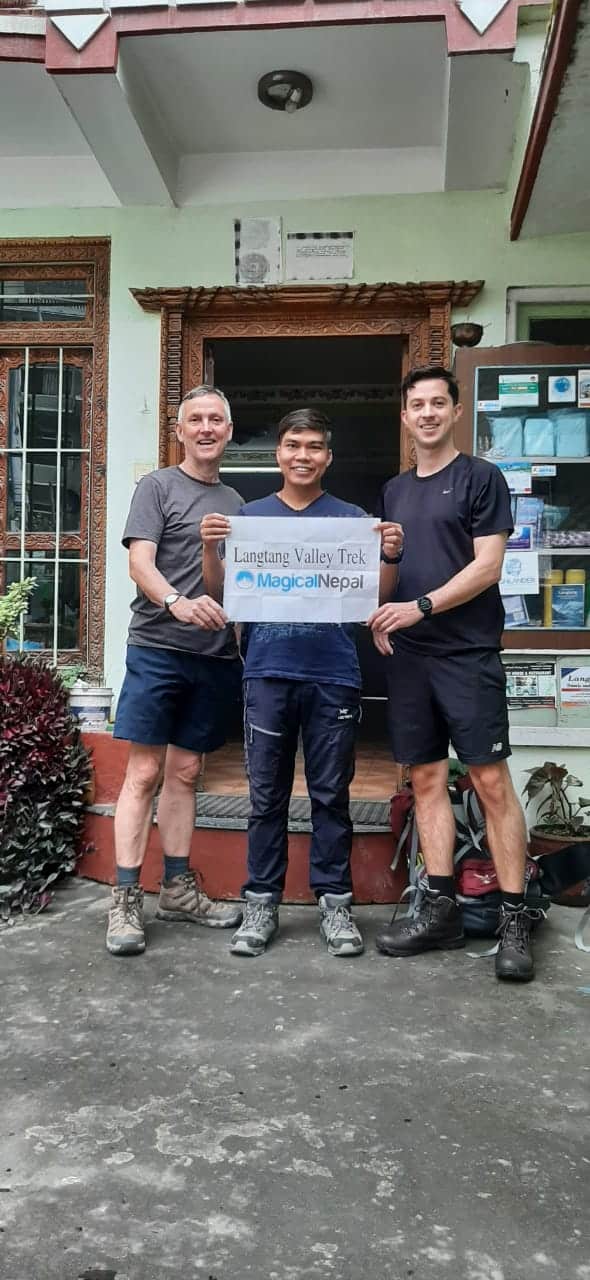
This is the final day of the trek, and there are options! Two routes take us back to Syabrubesi. We can either retrace our outbound route through the forest and the villages of Bamboo and Rimche, reaching Syabrubesi in about 6 hours, or take a shorter but steeper route with stunning views of the Langtang Valley.
The second route goes via Rimche and Sherpa Gaun. Depending on the weather and stamina level, you can decide which route to take. We overnighted in Syabrubesi.
Day 8: Syabrubesi to Kathmandu (Drive)
- Drive time: 6 hours
- Accommodation: Tea House
- Distance: 122 km /75 miles
Today we retrace our journey along the highway back to Kathmandu.
Not satisfied with this Itinerary?
Are you interested on planning custom trip? It only takes 2 minutes.
Includes
- 7 nights accommodation in mountain teahouses
- Guide for 8 days
- Kathmandu Syafru Beshi Kathmandu local bus
- Langtang national park permit
- Trekkers information management system card
- 8 x breakfast, 8 x lunch and 7 x dinner while on trek
- One porter for 8 days USD 184 (Optional)
- Private Jeep USD 240 (Optional)
Equipments
The checklist gives you an idea of trekking equipment and clothing needed for the Langtang Valley Trek
Langtang Valley Trek Map
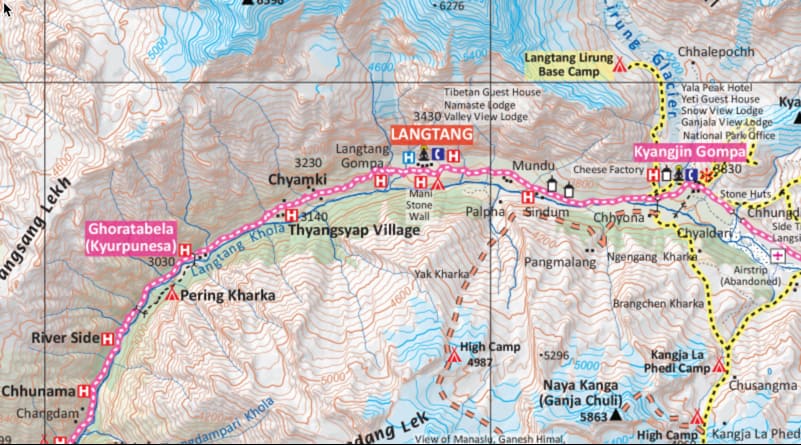
Related Trip in Langtang Region
A Typical Day on the Langtang Valley Trek
You will have a trip to remember whether you are heading off for three weeks camping in snowy conditions or hiking through lowlands in lush green vegetation and intense sunlight. The Langtang Valley Trek will provide you with memories and photographs to last a lifetime.
The Langtang Valley trek starts and finishes at Kathmandu. There is no need to take a domestic flight to reach this area; local buses or a private jeep will get you there in a few hours.
But just because it is close to Kathmandu doesn’t mean the mountains you see are less spectacular. The high mountains on this trek include Dorje Lakpa (6,990m / 22,933 ft), Langtang Ri (6,370m / 20,898 ft), and Langtang Lirung (7,245m / 23,769 ft). There are also lush forests and Buddhist culture to witness.
With no two days the same, there is a similarity. Your first and last days will be spent traveling to and from the starting and ending points of the trek at Syabrubesi. The other five days of this eight-day trip happen something like this…
Our day starts around 6 or 7 am with breakfast in the dining room of the teahouse we have slept in. To make things run more smoothly, your guide will have given your breakfast order to the kitchen the night before. After breakfast, your porter, if you have one, will start off ahead of you with your bag. You must carry your day pack with water, sunscreen, snacks, and whatever you think you might need for the day.
Then it’s time to head off with your guide. You will recognize some of the sights from the description your guide gave you the night before. For example, he will describe Buddhist artifacts such as prayer flags, mani stones (rocks with Buddhist inscriptions carved), and Buddhist shrines. During the trek, he will explain the names of some of the mountains and if they have any unique significance to locals.
Lunch on treks is usually taken at small tea shops along the way. On this particular trek, on the day we overnight at Kyanjin Gompa, we reach there by lunchtime itself so we will enjoy both lunch and dinner there.
When staying in teahouses (trekking lodges), it is usual to order from the menu on arrival to give them time to prepare the meals. Then you can wash the day’s dust off! During and after dinner, there is plenty of time to talk with other trekkers and discover from your guide what you will be seeing the following day.
Since the day starts so early and walking can be tiring, bedtime is never late on any trek.
What to Expect in a Teahouse in Langtang Valley Trek
A teahouse is like a simple guest house on the mountain trails. It provides trekkers with accommodation, meals, and a place to socialize. These provide pretty basic accommodation, either in twin rooms or in dormitories. Toilets and bathrooms are shared, with either a Western-style toilet or a squat style. Showers normally only have cold water; you will be expected to pay for it in those with hot water on offer. The sleeping rooms consist of beds, blankets, and not much else. Bringing your sleeping bag is always recommended. There are no ‘single rooms’ unless it is off-season, and you are lucky. Sharing a room is perfectly normal. There is no heating in the sleeping rooms.
Some stove usually warms the dining area. Light is provided by solar energy. Most teahouses have the ability to charge your gadgets, for which you have to pay. Breakfast and dinner are taken in the teahouses at communal tables where you can discuss the day’s journey with others. Some menus offer a variety of food. Boiled water is usually available, rather than in plastic bottles, which hurts the environment. There is a small charge for boiled water. Bringing your sterilization tablets/ life straws is a good idea.
Food on the Langtang Valley Trek

This is a relatively quiet trek, quite surprising due to its proximity to Kathmandu, and so the teahouses do not have quite as an extensive menu as those on the busy trails, which have seen tourists coming by for decades,
However, there will be several choices, such as Nepali dal bhat (vegetable curry, rice, and lentil soup), noodles, fried rice, and soup. For breakfast, there are eggs, toast, and porridge.
Tea and soft drinks are widely available at the teahouses. Coffee and alcohol may also be available. We advise you to keep your alcohol consumption low as it doesn’t mix with altitude.
Breakfast at your overnight teahouse on the Langtang Valley Trek:
- Spicy Nepali omelet with chili, onion, and tomatoes or piping hot porridge with milk
- Toast with jam or honey
- Nepali spiced tea or coffee (most likely instant coffee outside the bigger settlements).
Lunch on the Langtang Valley Trek:
- Dal bhat (rice, curry, lentils) or noodles ie chowmein (when available)
- Nepali tea or a soft drink (where available)
Dinner at your overnight teahouse on the Langtang Valley Trek:
- Garlic or other soups
- Tibetan bread
- Fried macaroni with vegetables
- Pasta
- Custard
- Beer/ spirits (we recommend you limit your consumption at altitude)Tea/ coffee
Are There Hot Showers and Electricity on this Trek?
Yes, hot showers are available, but you must pay for them. Why? Gas canisters are brought in from nearby cities and carried to teahouses. That is an expensive journey. You will be expected to pay around $3 to $5 per shower, depending on the height of your lodge. We recommend you conserve energy (and your money) and don’t shower too often. And the effort to take off and put on clothes might be too much in the cooler weather.
As for electricity, most teahouses now depend on solar power, installed at a considerable cost. Therefore, they will ask you to pay to charge your equipment – $3 to $5 per item. We suggest you carry your power bank or portable solar charger.
How High Will I Go on The Langtang Valley Trek?
The highest point for this trek is at Tserko Ri, which is 5,000m / 16,404ft. This, however, is a day hike and you return and sleep at Kyanjin Gompa which is 3,870m / 12,696ft.
Trek Difficulty and Physical Fitness Required for the Langtang Valley Trek
This is a moderate trek, as the paths are not too difficult, the number of days is quite short, and the altitude is not very high. However, you should have a good general health to tackle and enjoy any trek in Nepal.
Will I Suffer from Altitude Sickness on Langtang Trek?
Generally, we consider heights above 3,000m to 3,500m to be in a range where some people may feel the impact of altitude. This trek is not particularly high but everyone has a different tolerance level.
The guides at Magical Nepal are trained in first aid and how to recognize and what to do in the case of altitude illness. If you feel unwell, do not hesitate to tell your guide.
Overall, the best way to avoid problems related to altitude is to keep hydrated and go slowly.
Extending your Stay in Nepal
If you are interested in staying longer in Nepal, we can organize that for you too, and make recommendations as to the best treks to suit your time and budget. Please ask us.
If you would like to visit another part of Nepal, we can recommend both Chitwan National Park and Bardia National Park. Or if your time is short, we can provide Kathmandu Heritage sightseeing with a guide, taking you into a fascinating ancient world and culture.
Trip Extension National Parks
Chitwan and Bardia National Parks in Nepal offer distinct experiences due to differences in location, accessibility, facilities, and wildlife. Chitwan, conveniently located just a 5-hour drive or a short flight from Kathmandu, boasts decades of visitor access and a range of accommodations, from luxurious options to budget-friendly choices in the bustling tourist town of Sauraha. Visitors can enjoy diverse dining and entertainment options in Sauraha, while wildlife enthusiasts can partake in walking safaris, jeep tours, and canoe rides to spot rhinos, deer, leopards, monkeys, and smaller mammals, although tiger sightings are less common.
Meanwhile, Bardia National Park, situated at the opposite end of Nepal, requires a longer journey of approximately 12 hours by road or a combination of a 1.5-hour flight and a 2-hour drive. This park offers a more secluded and rustic experience, with fewer tourists and accommodations that reflect the local ambiance. Wildlife enthusiasts can explore the park’s diverse ecosystem, which is home to tigers, elephants, leopards, monkeys, deer, and various bird species, while activities like jeep and walking safaris, river rafting, and fishing are available for adventure seekers. Nightlife in Bardia is typically limited to lodge settings, offering a tranquil retreat amidst nature’s splendor.
Cost and the Booking Process for the Langtang Valley Trek
You can book your trek and other trips via our booking system, which will collect all the necessary information from you. You can pay the deposit or the full amount via credit card. You can learn more about the cost of the Langtang trek here
Do I Need a Porter for Langtang Valley Trek?
The cost of this trek does not include a porter. Should you require a porter there is an extra charge per porter. If you hire a porter, please be considerate. Porters cannot carry everyone’s pack! The weight limit they can carry is 20kg. Or one porter for two clients.
These amazing people are used to walking at altitude and on these rough trails, so they walk faster than the average trekker. As they head off ahead of you and reach the teahouse first, where they will deposit your bag, please ensure you carry what you need for the day with you.
Charging Your Equipment on the Langtang Valley Trail
Everyone carries electronic equipment these days: phones, cameras, iPads, etc. But on most treks in Nepal, basic facilities have not caught up with modern-day technology. The majority of electricity in the teahouses is generated by solar energy. Someone carried those solar panels up the mountains, and the teahouse owner had to pay for and maintain them. So it’s only natural they pass this cost on to you. Generally, teahouses will charge you $2 to $3 for your phone or camera. This can become expensive as there are so many wonderful things to photograph. We recommend you carry a power bank or a small solar charger to avoid paying too much. Some great solar chargers clip onto your day pack.
Will I be Able to Communicate with Those at Home During the Langtang Trek?
There are Wi-Fi and cellular signals at all stages of this trek. This is weather-dependent, however. And trickier as you go higher. Let friends and family know you may be out of communication for several days, so they do not worry.
Group Size for the Langtang Trek
Your trekking group is generally 8 people, but it is often smaller. If you require a tailor-made private trek, you can choose this option at no additional cost during checkout.
We have found that trekking with a group makes the trip more fun, especially during the evening relaxation.
I Don’t Want to Travel by Public Bus – What is the Alternative?
We can arrange a private jeep to take you from Kathmandu to the start of the Langtang Valley Trek, and back, if required. The additional cost will be around USD 260 per jeep. One private jeep holds 4 guests, the driver, and your guide.
Arriving in Kathmandu
We will pick you up at the airport in Kathmandu and take you to your hotel. If you are late (flight delay etc.) and have been unable to contact us to let us know, please make your way to the hotel. There are pre-paid taxis at the exit of the airport, which will cost you around Nrs 1000 to Thamel. Few people might come up to help you with your bag and later ask for money. Ignore them.
Travel Insurance for the Langtang Trek
While our insurance covers our team, you are not covered by this. Please ensure you have the correct travel insurance before leaving home. That is insurance that covers trekking at high altitudes and the cost of helicopter rescue in the unlikely event it will be necessary.
Safety and Security in Nepal and on the Langtang Valley Trek
In general, Nepal is a very safe country. But please check your home government’s website for the latest information. There may be demonstrations – if you see one, please avoid it. Theft is unusual, but it does happen. Ensure all your valuables are hidden from sight. You can leave any valuables in our office locker while on your trek.
It is unlikely, but if there is any landslide, avalanche, or earthquake on the mountain, please follow instructions from your guide. Similarly, if you feel unwell at all, please advise your guide.
You will see the village of Langtang on this trek. This used to be the center of this area until the 2015 Nepal Earthquake. These days we sleep in the next village as locals rebuild Langtang village.
Tipping Culture in Nepal
It is expected in restaurants and cafes to tip 10% of the bill. Tipping your driver, porter, guide, and other staff on your trek is also normal. Please tip drivers of private vehicles separately. $1 to $5, depending on the length of the journey. Normally tips for the trekking crew are given as a group and depend on the group’s satisfaction.
How Much Cash Should I Take on Langtang Trek?
We recommend you carry between USD10 to USD15 per day on the trek. This will cover things like hot showers and charging batteries. It also will cover the occasional soft drink or beer. It will not cover tipping your crew/guide on longer treks.
Money Exchange in Kathmandu
There are plenty of ATMs in Kathmandu that provide Nepali currency. Please bring any cash you need for the trek itself. We suggest $10 to $15 per day, covering showers, charger fees, and a minimum amount of soft and alcoholic drinks. The ATMs accept Visa and Mastercards and have a limit on each withdrawal. Some shops accept Visa and Mastercard, but there will be a 3 or 4% charge for each transaction. The rate of exchange varies daily at both ATMs and money changer booths. Money changer booths will only change hard currency into Nepali rupees. They do not accept cards. Often it is easier to bring some US dollars, Pounds, Australian Dollars, Singaporean Dollars, Malaysian Ringgit, and Euros with you.
Feedback on the Langtang Valley Trek
After your trek, we would love to hear from you about how you enjoyed the trip and any suggestions on improving the experience for others.
Important Notes for the Langtang Valley Trek
- Transport to and from the starting point of the Langtang Valley Trek is by public bus. Should you require private transport, there is an additional fee for this. Please ask us.
- There is no extra charge for a solo traveler. But please note it is highly unusual you will be able to get a single room on the trek. Expect to share with someone (of the same sex).
- This trek does not include any accommodation in Kathmandu. If you would like us to book this for you, please let us know in advance.
- Porters are not included in the package price. Should you wish a porter to carry your gear, please ask us before the trek and note it will cost around an additional USD142.
- If you do hire a porter, the maximum he can carry is 20kg. Please be respectful of this.
- Meals on the trek are included in the price. This does not include hot or cold drinks, alcohol, snacks, or extra food.
- There are extra charges for hot showers ($3 to $5), and charging your battery ($1 to $3), payable directly to the guest house.
- Please bring around USD10 to USD15 per day on your trek in Nepali rupees to cover additional charges such as hot showers and tips. This will not cover tipping your trekking crew, which is normally done by the group as a whole, depending on the satisfaction you all feel.
- Always listen to your guide. He has experience in this area and if there are sudden changes to be made (because of weather or landslides) he will be responsible for making decisions.
- Drones are not permitted unless you have a special permit to fly them. It is a bit tricky to obtain permission, so leave it at home unless you have a real need for a drone.
- Please arrange trekking insurance before leaving your home country. We do not provide insurance for our clients.
- Happy trekking!
- Satisfied Client
- Personalised Guide
- Instant Response
Get Instant Response:
+977-9851329446 (Whatsapp)
